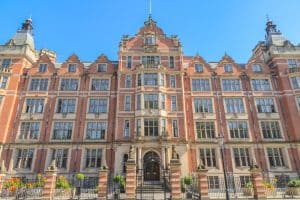The London School of Economics and Political Science (LSE)
The London School of Economics and Political Science (LSE) provides the opportunity to study social sciences at an institution with a global academic reputation while enjoying the cultural, social, and recreational amenities of one of the world’s finest capitals.
The said school is a hub for true intellectual stimulation and cutting-edge research. It has the highest proportion of world-leading research in the most recent national Research Excellence Framework (REF) of any university in the United Kingdom.
What school is LSE?
What school is LSE then? Well, it is one of the top colleges for social science in the world. It has departments for economics, politics, sociology, law, and anthropology, among many others. It is also a center for cutting-edge research and true intellectual enthusiasm. In the most current national Research Excellence Framework (REF), this institution had the highest proportion of research that was at the top of its field of any UK university.
It provides more than 40 undergraduate programs, and its academic profile includes a wide range of social science fields, from management to social policy and from accounting to law.
Since it approaches all of its teaching and research from a social science viewpoint, the school has a distinctive perspective on subjects that are otherwise widely studied. Academics at the school are at the vanguard of social scientific advancements, and media outlets, businesses, and governments all around the world rely on their knowledge.
More than 40 undergraduate programs and 140 taught and research postgraduate programs are available. The academic profile of the institution includes a broad range of social scientific fields, including management, law, and social policy.
LSE’s personality cannot be separated from its environment. The School is located in one of the most multicultural cities in the world, central London. It is situated at the center of global discussion and is just a short drive from Europe’s financial, legal, and cultural hubs.
This is essential to who we are as an institution that is engaged in both domestic and international issues and is outward-looking.
With students from over 140 nations registering each year, the student body at the school is one of the most multicultural in the entire globe. This combination fosters a truly worldwide approach to academic life and intellectual inquiry at LSE that is unmatched elsewhere.
One of the most prestigious public events programs in the world is offered by the School. Leaders from all spheres of life, including Bill Clinton, Nancy Pelosi, Amartya Sen, Christine Lagarde, Bill Gates, Helen Clark, and George Soros, have delivered speeches at the said school.
What is LSE known for?
Do you want to know what LSE is known for? Across the world, a degree from the said prestigious school is generally recognized. The school has produced over 37 heads of state and world leaders, 18 Nobel Prize winners, and a large number of alumni who are well-known both domestically and abroad.
The school hosts presentations on jobs from a number of prestigious organizations throughout the year, and LSE Careers provides a wealth of tools at your disposal to help you with your employment hunt. Learn more about the assistance offered to students via LSE Careers.
Why LSE?
Now you may ask, why LSE? This prestigious school provides a special chance to study social sciences in a university with a distinguished academic reputation while taking use of the cultural, social, and recreational resources of one of the most cosmopolitan capital cities.
You might want to look at the LSE Life sections as well. You can study social sciences at the London School of Economics and Political Science (LSE), a renowned academic institution, and take use of the cultural, social, and recreational resources of one of the largest capital cities in the world.
The heart of London
The school is in the middle of international conversations and is only a short drive from Europe’s financial, legal, and cultural centers. This location is important to who they are as an institution that looks outward and is involved in UK and world affairs.
It is energizing, international, and very much a part of the “real world.” These characteristics result from the diversity of the school’s faculty and students, from its active academic and political concerns, and from the ease with which ideas can be exchanged between the school and the outside world thanks to the proximity of the school to the government, parliament, business and financial institutions of the city, the courts, and the media.
Leading academics from around the world visit the school each year to participate in teaching, deliver public lectures, and conduct their own research. These speakers include significant national and international politicians, business executives, industrialists, and government officials. The fact that LSE is small and packed to the gills with students and staff adds to the community and friendliness of the setting.
A global hub for education and research
Our teaching is continually informed by and revitalized by our research. By conducting research as part of their studies, graduate students also contribute significantly to the School’s commitment to scholarship.
Through academic departments, institutes, and a variety of interdisciplinary research centers, the school supports the staff’s research. Approximately 97% of the faculty members are actively involved in research.
Staff members frequently receive requests to serve as advisers, consultants, and commentators, allowing them to participate in the application of the subjects they teach and conduct research in.
Many former and current employees serve as knowledgeable advisors to political parties, the Civil Service, and pressure organizations for particular policies. For instance, Emeritus Professor Lord Wallace was a government whip in the coalition government, Emeritus Professor Lord Wallace served as chair of the independent UK Migration Advisory Committee from 2007 to 2016, and Emeritus Professor Lord Metcalf, founder of the Centre for Economic Performance, is a well-known authority on happiness and the first Director of Labour Market Enforcement.
The media always turns to LSE for a response in times of crisis because of the School’s global reputation and location in London. The average news junkie will be familiar with the names of Professors Nicholas Stern (climate change), Conor Gearty (human rights), Anne Power (housing policy), Tony Travers (London and local government), and Danny Quah (the weightless economy).
Research excellence
The Higher Education Funding Councils examine the quality of research at universities across the UK every five to seven years through the Research Excellence Framework (formerly known as the Research Assessment Exercise, or RAE). The School topped or came very close to the top of a number of rankings of research excellence, which served as evidence that LSE continues to be a premier research university in the world.
The REF not only reveals outstanding overall achievements but also several departments at the top of national research rankings. With their Units of Assessment placing first overall, the departments of Economics, Anthropology, Social Policy, Health Policy, and Media and Communications did very well. These top-scoring Units of Assessments also included academic contributions from the Departments of Gender Studies, Methodology, and Psychological and Behavioural Science.
Where Is LSE?
Now the important question, where is LSE located? The institution is located in Houghton St, London, WC2A 2AE, United Kingdom. Let’s discuss getting there in this area.
Tube/Underground stations
- Corner of Kingsway and High Holborn, Holborn (Piccadilly and Central lines). Five minutes away, roughly.
- Temple (District and Circle lines) is located at the bottom of Arundel Street on the Embankment. Five minutes away, roughly.
- Charing Cross, on the Strand near Trafalgar Square (Jubilee, Northern, and Bakerloo lines). About five minutes’ drive away.
National rail stations
- Over the Waterloo Bridge, on the opposite bank of the river from the Strand, is Waterloo. About ten to fifteen minutes away. trains that travel to and from England’s south coast and south west.
- At the end of the Strand closest to Trafalgar Square is Charing Cross. It is around ten minutes away. trains that primarily travel to Kent and south-east London.
- Blackfriars – on the Embankment near Blackfriars Bridge. Approximately 10 -15 minutes away. Trains mainly to south London and south east England but also the Thameslink line through north London.
- St Pancras International – on Euston Road, close to King’s Cross mainline station. Take the Piccadilly Line from King’s Cross to Holborn, from where it is a 5 minutes away (see ‘Holborn’ above). Serves the Eurostar and trains to the Midlands.
Buses
- Bus numbers 1, 4, 6, 9, 11, 13, 15, 23, 26, 59, 68, X68, 76, 77a, 91, 139, 168, 171, 172, 176, 188, 243, 341 and 521 all stop on or near Aldwych.
- Live arrival updates for buses No longer are electronic arrival readouts available at every bus stop in LSE. If you have access to a mobile phone, you can access live updates in their place (aside from at select locations around London).
- For a real-time update on when the next buses will arrive at each bus stop, a special text message code is displayed next to each stop. You may also download a variety of apps to your smartphone to customize them with the stops you frequent the most.
- Bus stations display the routes and stops of the buses that pass by. In case the bus is not taking the entire route, also look towards the front of the bus where the end destination will be indicated.
Cycling
- The St. Clement’s Building, Grange Court, the main entrance on Houghton Street, and Sheffield Street all have bike racks for your use.
- On the campus, there are 384 open-access bike racks. The biggest racks may be found at Clements Inn, John Watkins Plaza outside the Library entrance, and Lincoln’s Inn Fields across from the New Academic Building. Anyone utilizing one of these racks must secure their bike with a padlock, not a D lock or chain, in order to prevent theft.
- We have additional safe parking places and amenities, such as showers and repair stations, if you are a member of the community.
- There are two Santander Cycle Hire docking stations on the campus, located on Portugal Street and Houghton Street.
- Please be aware that bicycle theft does occur in London’s city center, especially on the LSE campus. Please alert the security if your bicycle is stolen.
Parking
- Parking is subject to both London’s Ultra Low Emission Zone and Congestion Charge (ULEZ). You must pay to enter the zone on weekdays from 7 am to 6 pm if you drive. If you enter the zone at any time in a vehicle that does not comply with the ULEZ emissions regulations, you will be required to pay the ULEZ fee.
Are you thinking about beginning your future with LSE? Then let’s talk about the admission process. The experts at AdmissionSight have been helping students get admitted to their dream colleges for more than 10 years. Book a free consultation and take the first step on your epic journey.









































